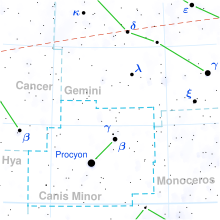Top Qs
Timeline
Chat
Perspective
Delta2 Canis Minoris
Star in the constellation Canis Minor From Wikipedia, the free encyclopedia
Remove ads
Delta2 Canis Minoris is a single star in the constellation Canis Minor. Its name is a Bayer designation that is Latinized from δ2 Canis Minoris, and abbreviated Delta2 CMi or δ2 CMi. An apparent visual magnitude of 5.57[2] means it is deemed visible to the naked eye but faint and requires a dark sky to view.[11] Based on parallax measurements it is calculated to be 141 light-years (43 pc) distant from the Earth.[1] It is drifting further away from the Sun with a line of sight velocity of +3 km/s.[1]
The star figures from this part of the Milky Way galaxy as the more central of three that share the Delta designation (the greek-lettered catalog is that of Johann Bayer's 1603 Uranometria atlas of bright stars) in star atlases very close, southwest of Delta3 Canis Minoris which is physically unrelated. The Flamsteed designation for this star is 8 Canis Minoris in John Flamsteed's 1712 star catalog.
Remove ads
Properties
This star is rotating rapidly; the projected rotational velocity is 117.6 km/s,[12] which means that the equator of this star is rotating at this velocity or greater. By comparison, the Sun is a slow rotator with an equatorial azimuthal velocity of 2 km/s.[13] δ2 Canis Minoris has a stellar classification of F2 V,[3] indicating that this is an F-type main-sequence star that is generating energy at its core through thermonuclear fusion of hydrogen. The effective temperature of the photosphere is about 7053 K,[14] giving it the yellow-white hue that is characteristic of F-type stars.[15] The radius of this star can be estimated indirectly based upon the measured brightness and color information, which suggests the star is about 86% larger than the Sun.[7]
As of 2008, no companion has been suspected or found orbiting δ2 Canis Minoris.[8][16]
Remove ads
References
Wikiwand - on
Seamless Wikipedia browsing. On steroids.
Remove ads

